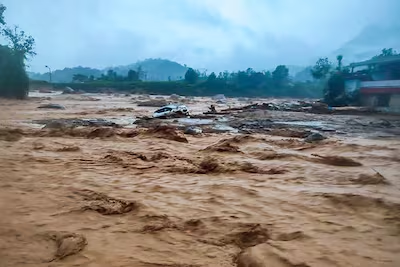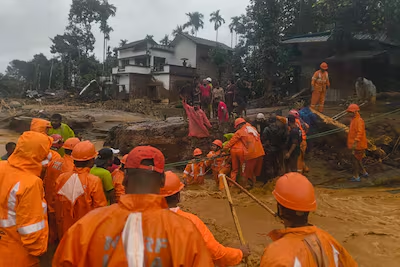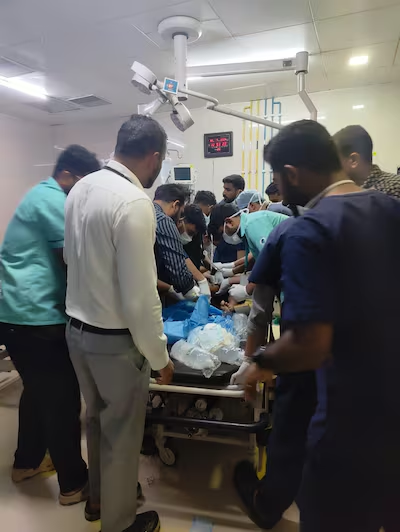At least 98 people have been killed and more than 100 are feared trapped under debris after landslides hit hilly areas in India's southern Kerala state on Tuesday, government officials told The National.
The first landslide occurred at 1am in Meppadi, in Wayanad district, officials said.
Wayanad, a hilly region in the Western Ghats mountain range, is a popular resort area surrounded by lush tea estates. It has borne the brunt of heavy rains for the past few weeks.
As rescue operations launched, a second landslide struck near a school at Chooral Mala in the region at 4am.
The school was being used as a camp for survivors of the earlier landslide, and nearby houses and shops were flooded with water and mud.
"We have found 98 bodies. This includes 25 bodies recovered from downstream in the neighbouring Malappuram district. The post mortem is being done. More than 100 people are injured and are under treatment," Kerala Health Minister Veena George told The National.
Ms George said rescue work was still under way and described the situation as grim, particularly in the Mundakkai area which had the largest number of casualties and where hundreds of residents and plantation workers remain stranded.
Kerala Chief Minister Pinarayi Vijayan declared a two-day state mourning for victims of the tragedy.
The UAE offered its condolences to the Indian government and families of the victims, as well as wishes for a quick recovery for those injured, in a message conveyed by the Ministry of Foreign Affairs.
The area of the landslides received 572mm of rainfall in 48 hours, according to the India Meteorological Centre.
Mundakkai is about 4km from Chooral Mala, but personnel from the National Disaster Response Force (NDRF) and the army took 13 hours to reach it as they had to cross a river in flood after the bridge connecting the two places was swept away.
"It is difficult to reach them but we are trying everything to save them," Ms George said.
"A government and a private hospital are at least 15km away so we have set up a temporary hospital in order to stabilise the rescued people. Since the Air Force personnel has landed, they are now doing the rescue."

The Indian Army sent a team of 225, including medical experts, and was sending a canine squad to help the search for survivors and bodies.
The Indian Air Force sent two helicopters to assist with rescue operations.
TV images showed emergency workers using ropes and equipment to reach people trapped under mud and fallen trees as muddy water from the river gushed through the area.
Vehicles washed away in floodwaters were seen stuck in tree trunks.
Visuals on social media showed a man clinging desperately to a boulder in a torrent of muddy water as people watched helplessly. It was not known if he was rescued.
“There are more than 200 people waiting – 100 stuck in a resort, 50 in a mosque, many on a hill, they are all on one side of the river,” Shamshad Marakkar, District Chief of Wayanad, said.
“Rescue teams have to move slowly because they can only pull one person across at a time," he said.
“More than 200 houses are swept away,” Alice Arakkal, manager of Wayanad Ranches Resorts, told The National. “Our staff’s houses have been swept away. One of the staff’s sister houses is affected. My friends and relatives are safe but they don’t have electricity.”
Ms Arakkal said she had been anticipating a tragedy given the amount of rain.
“Our town is on the top of hills and there is a river. I am hearing reports that several people were swept away, and their bodies have been found downstream.
“It is the fault of the government. They could have taken efforts to move the people to a safer location.
“It was raining heavily for more than two to three weeks. I was expecting something like this to happen, we were alert. It was such a massive rain,” she said.

Doctors were treating patients with major fractures and hypothermia after being in the water for prolonged periods.
Wayanad Medical College said more than 60 people had been brought to the hospital, eight of whom were dead.
“There were major fractures due to falling debris and big bone fractures leading to haemorrhagic shock,” Dr Sarfaraz Shaikh, head of the emergency medicine department, told The National.
“Many elderly women were brought in with hypothermia as they were submerged in water for hours and in shock.
“Some people were brought to us in pretty bad shape. Those with open major fractures required emergency surgery and they were rushed to the operating theatre.”
The hospital is bracing for a surge of patients as rescue teams reach the main villages hit in the series of landslides.
“This is such a tragedy. We have patients of all ages from paediatric patients to elderly,” Dr Shaikh said.
“They were sleeping in their homes at night when the landslides happened. We are expecting many more patients as the relief teams reach the site of the tragedy.
“So many areas are still cut off because bridges have collapsed and teams are trying to reach people who are trapped.”

Prime Minister Narendra Modi said he was “distressed” by the landslides and has offered 200,000 rupees ($2,388) compensation for the families of the deceased and 50,000 rupees ($598) for those injured.
Rahul Gandhi, the leader of the opposition and the former MP from Wayanad, is expected to visit the region.
The state of 34 million people witnessed the worst floods in a century in 2018 when severe rains triggered flash floods and landslides that killed about 500 people and left a million homeless.
The following year, more than 125 people were killed in flash floods and landslides across Kerala.
More than 50 were killed in August 2020 after landslides struck the hilly Munnar region, and at least 23 were killed in landslides in the Kottayam and Idukki districts in October 2021.
In 2011, a government committee headed by ecologist Madhav Gadgil recommended that all of Western Ghats be declared a sensitive region and “almost all developmental activities such as mining, thermal and power plants restricted in it”.
Experts say development such as constructing roads, buildings and quarries in sensitive areas of the state, have damaged the region, with regular downpours causing soil erosion and landslides.













